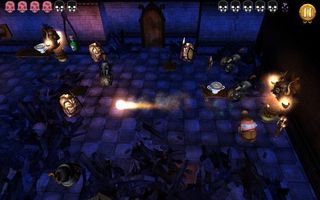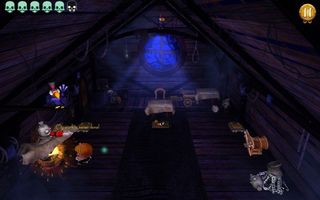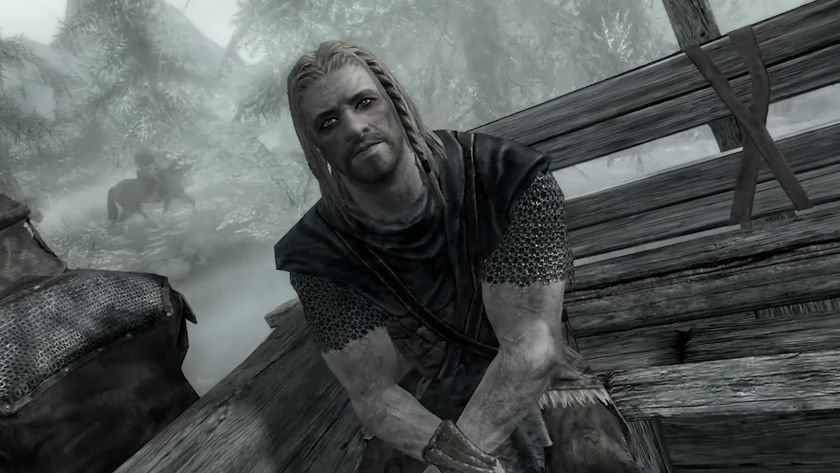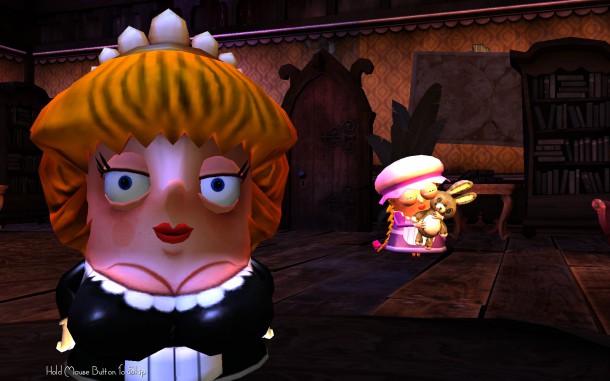Our Verdict
A promising concept but dismal execution on just about every level.
PC Gamer's got your back
Expect to pay: $10 / £7
Release: Out now
Developer: The Odd Gentlemen
Publisher: Moonshark, Inc.
Multiplayer: None
Link: whohauntsneil.com
If you love puzzle games and Neil Gaiman, I have some great news for you: there are a lot of great puzzle games and Neil Gaiman books out there for you to enjoy! I also have some bad news.
Wayward Manor sounds like fun: a creepy old mansion is full mean, tacky people, and it's your ghostly duty to haunt them until they flee in fright. Throw in a Neil Gaiman story and hand it to The Odd Gentlemen, the studio behind the highly enjoyable The Misadventures Of P.B. Winterbottom, and it sounds like a great game. The only problem is: everything.
Puzzles first. You can use your supernatural powers to interact with objects—knock a bottle off a shelf, blow open some window shutters, rattle a statue—to either frighten one of your awful tenants or move them to a spot where they can be spooked by another activated object. Each fright adds to their spook meter, and when their meter is full, they flee.

When the puzzles are easy they're not particularly satisfying, amounting to a series of clicked-upon objects followed by the wait to see the results. When they're hard, on the other hand, it's often not the result of the puzzle's complexity but of the game's poor response to player input. Getting a rat to run into the maid's path to startle her or flinging a bottle across the room to strike a walking burglar requires precise timing, and that timing is often scuttled by the object not activating when you want it to. A bit of character animation playing can prevent you from launching a scare, and sometimes activating one object prevents you from immediately activating another. Having your timing disrupted because the game is not responsive enough quickly becomes frustrating.
Phantom pains
Each character you haunt has a particular theme to their fears, and after facing them individually the game begins to throw them together in different combinations. This doesn't lead to the fun mix-and-match spookery it aims for: more often than not, the game confuses complexity with clutter, adding so many objects that it becomes a tedious exercise in trial-and-error instead of strategy. On the plus side, there are always multiple ways to fill the spook meter.
I was brought to the brink of enjoyment at times. Rotating shield-bearing statues so that a crossbow bolt gets bounced around the room is nearly satisfying, but like all of the game's puzzle elements, it never really grows more challenging and it gets repeated, repeatedly. I also almost enjoyed using my powers to reunite a little girl with a stuffed rabbit, but having to sit there helplessly watching other characters slowly and repeatedly yank it from her hands and throw it somewhere else in the room was tiresome.

If I liked any of this, I would have liked the game's "secret scares" the best. After completing a level, you're shown a list of three challenges for the room you just beat, allowing you to go back and win it again while accomplishing some specific feats. (Trick the burglar into destroying every piece of china in the room, for example.) I did replay a few levels to complete the secret scares, and the specificity of the added goals brought a little focus to the otherwise meandering puzzle-play.
Another thing I would have praised if it were described to me but I hadn't actually experienced it: Wayward Manor gives each character their own musical theme. When a little girl walks across the room, she gets some flute music, and when she's yelled at by an angry fop, a trumpet blares. Once more, though, it just doesn't, uh, score. These themes are uninspired and repetitive and quickly become irritating, especially when multiple characters are in a room together and their themes keep interrupting each other.
The rest of the game is just as disappointing. The sound effects aren't exciting or funny, even for a haunted mansion the screens are much too dark, and the art style aims for a charming quirkiness but manages neither. The animation is also bland: tricking someone into smashing into a china hutch, with the right animation and sound, could be—should be—funny or satisfying. It's not: the trolley just sort of rolls over. There are kegs of TNT that can be shot with flaming arrows, yet when they detonate they simply fall apart into a small pile of boards. Even at the end of each level, when everything in the room levitates and turns into a whirling, spectral tornado... it's just rather dull.

On top of all this, glitches and bugs forced me to reload a number of levels repeatedly, the volume sliders didn't actually adjust the volume, and the game auto-skipped the final two act-break cutscenes. A few hours after the game was released a couple of bug-fixing patches were hurriedly pushed through, though I did re-test the final two act-breaks and they still auto-skip. It's just another indication, of many, that this game needed more time in the oven. If you're in need of a Gaiman fix, stick to his books.
A promising concept but dismal execution on just about every level.

Chris started playing PC games in the 1980s, started writing about them in the early 2000s, and (finally) started getting paid to write about them in the late 2000s. Following a few years as a regular freelancer, PC Gamer hired him in 2014, probably so he'd stop emailing them asking for more work. Chris has a love-hate relationship with survival games and an unhealthy fascination with the inner lives of NPCs. He's also a fan of offbeat simulation games, mods, and ignoring storylines in RPGs so he can make up his own.

No More Room in Hell 2's 'biggest update yet' introduces weapon attachments, new level scenarios, and ensures players no longer spawn 'without a body'

A Skyrim dev broke the game before launch when they made thousands of tiny ants cast individual shadows: 'Why is the game running so slow?'

Today's Wordle answer for Saturday, February 22
